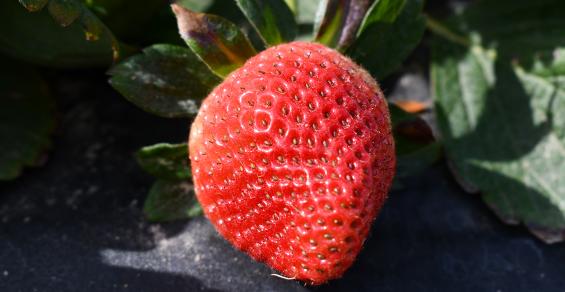Strawberries bring the family and community together in Albany, La.
While Mrs. Heather’s Farm is a fun place to explore a commercial farm, owner Heather Hughes is serious about her family’s operation and the multiple crops they produce, including strawberries.
Heather and her husband, Trey Hughes, farm about 800 acres with multiple crops and roughly 300 head of cattle. The farm is split between two sites with a pumpkin patch in Hammond, La., and a strawberry patch in Albany, La.
Strawberry production began in 2001 and now stretches across 10 acres, in multiple fields. The farm includes outdoor toys such as a sand mound, swings, old-style hand-driven water pumps, a bouncy house, not to mention face painting for kids, but the focus is definitely on agricultural production.
South Louisiana provides a good environment for Camino Real strawberries. (Brian Ireland)
The strawberry farm hosts tours during the season every day from 9 a.m. to 4:30 p.m. and accommodates school field trips, weddings, special events, and the everyday you-pick strawberry access.
“The variety we grow is Camino Real,” Heather Hughes said. “This variety is patented and comes out of California.”
The Camino Real variety is a short-day strawberry, also known as June-bearing strawberries, which typically produces a large single crop that must be planted each year. Being a patented variety, Hughes is unable to replant the runners and the crop must be replaced yearly.
Buying acres worth of baby plants can add up fast, but planting bare roots continues to be the cheapest option.
“When you’re planting 150,000 plants, it can add up fast,” she said. “It’s important to source materials so there are no issues when it comes time to use them. We go with a nursery out of California to get the roots.
“The breed of strawberries Camino Real are patented. This means we are not allowed to plant runners or alter the plant.”
Grandparent inspired
The interest in strawberries began with Trey’s grandparents who planted them in their seasonal garden. Heather and Trey began farming in 1980 with a herd of dairy cattle.
Like many farmers, they transitioned to various crops and livestock depending on the market. The Hughes love the community and began incorporating a pumpkin patch and strawberry patch for everyone to have a place to make memories.
“We originally owned a dairy farm for 16 years,” she explains. “We then transitioned to the pumpkin patch in 1996 and the strawberry patch in 2001.”
In Louisiana, bare roots are planted in fall around October and harvested in the spring.
Hughes said a lot goes into preparing for planting season. The ground must be prepared and fertilized. After the soil is formed into rows where drip irrigation is run and then covered with black plastic, the field is allowed to sit for a couple of weeks to settle before roots are planted.
Strawberries grown in elevated rows are covered with plastic to prevent contact with soil pathogens. (Brian Ireland)
“Irrigation is used via well water,” Hughes said. “We water in the evening or mornings as needed. Irrigation piping runs down each row before it can be covered with plastic and planted. Water usage has never been an issue for our area due to the shallow water table.”
COVID and inflation have caused many farmers to change their practices to reduce input costs but not all, she noted.
“We haven’t had to make any big changes to our process due to inflation or COVID,” she said. “We broadcast fertilizer as needed between crops. Strawberries are heavy feeders and require a lot of nutrients. Occasionally we use soybeans as a cover crop to help replace the nutrients in the soil.”
Cover crops
Cover crops like legumes add beneficial nutrients to the soil while preventing run-off from bare dirt.
“Strawberries prefer colder temperatures and we are usually done harvesting before the heat becomes an issue,” Hughes said. “For drought, we have irrigation for each row and use it as needed. We rarely have an issue with frost since we plant bare roots instead of plants.”
Many of the issues faced in strawberry production can be mitigated by selecting the best variety for the planting location.
“If I have any advice for other farmers looking to add strawberries to their crop, it would be to understand the commitment it requires,” she said. “Our week and weekends are dedicated to managing the businesses so there is little time for us to enjoy peacefully.”
Labor costs can be high, which is why there is a limited number of growers who can make that commitment.
Strawberries continue to be a major part of the Louisiana culture on Miss Heather’s Strawberry Patch. Thousands of people gather each year for the annual Ponchatoula Strawberry Festival, where growers showcase their products and interact with the community.




